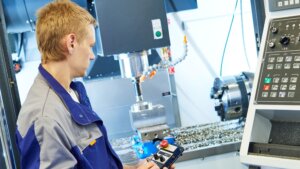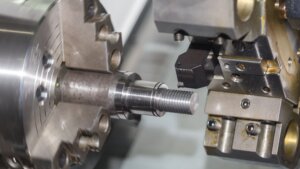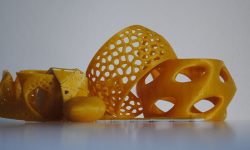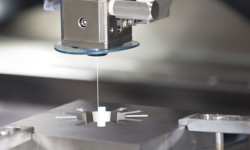Turning, a term that resonates throughout the industry, a technique that has paved the way for modern machining and has become the cornerstone of mechanical engineering.
With a single point cutting tool and a rotating workpiece, it opens up a world of precision cuts and intricately shaped components.
This article will unravel the ins and outs of turning, laying bare the parameters, operations, types, and equipment involved. Get ready to explore the world of turning, where raw materials are shaped into engineered perfection.
What is Turning?
Turning is a type of machining operation that involves a cutting tool removing material from a workpiece while it rotates around an axis. This operation is performed on a turning machine or lathe, a specialized tool that accommodates various geometries and materials.
With turning, operators can achieve a good surface finish and manufacture parts with high tolerances. It’s a process that allows for the creation of internal and external surfaces, even contoured ones, with unparalleled precision.
The Dawn of Turning: A Historical Perspective
Tracing the origins of turning takes us back centuries, to when manual lathes were used to shape wood and metals. The transformation of the process came with the introduction of Computer Numerical Control (CNC) technology in the mid-20th century, revolutionizing the industry.
Turning evolved from a manually controlled process to an automated one, enabling the production of intricate and accurate diameter components, limited only by the specifications of the machine and operator skill.
What is the Working Principle of Turning?
Turning operates on a simple yet effective principle:
- The workpiece is rotated at high speed while a single point cutting tool traverses along the workpiece’s surface, cutting off a thin layer of material.
- The cutting action takes place at the point where the tool’s cutting edge meets the workpiece.
- This cutting speed, coupled with the feed rate (the speed at which the cutting tool moves relative to the workpiece), determines the shape and surface finish of the final product.
What are the Stages of Turning?
The turning process unfolds in a series of carefully calibrated stages, which we will explore below.
Mounting the Workpiece
First, the workpiece is mounted onto the lathe. This is often achieved by fixing the workpiece between two centers or securing it in a chuck, allowing it to rotate around a fixed axis.
Tool Setup
Next, the single point cutting tool is positioned perpendicular to the workpiece surface. The tool’s cutting edge angle, rake angle, and relief angle, which determine the quality of the cut, are adjusted as per the desired outcome.
Cutting Process
Once the setup is complete, the lathe machine is started, and the workpiece begins to rotate. The cutting tool moves in a longitudinal direction along the rotating workpiece, removing material in the form of chips.
Quality Checks and Finishing
The last stage involves checking the workpiece for any imperfections and making necessary corrections. The final part is then measured for dimensional accuracy and surface finish, which may require additional turning operations such as finish turning or sizing.
What are the Different Types of Turning?
Turning is not a monolithic process, but rather a collection of methods, each with its unique characteristics and applications. Here are some of the most common types:
- Straight Turning: Straight turning involves the removal of metal from the external surface of a cylindrical workpiece. The cutting tool moves longitudinally along the workpiece, reducing its diameter. It is often used to ensure cylindrical workpieces have a consistent diameter along their length.
- Taper Turning: In taper turning, the tool is not parallel to the axis of the lathe, but at an angle, allowing for the creation of conical shapes. This technique is commonly used to create machine tool spindles and drive shafts that require a tapered end for fitting components.
- Facing: This operation involves reducing the length of a workpiece or creating a smooth end or face. The cutting tool moves radially across the end of the workpiece, removing material. It’s used frequently to clean up the ends of parts or prepare surfaces for additional machining processes.
- Groove Turning (or Grooving): This type involves cutting a narrow groove on the external or internal surface of the workpiece. Groove turning is commonly used for oil grooves, retaining ring grooves, and for parting off sections of a workpiece.
- Parting: Parting or cutoff is the operation of cutting off a piece from a larger workpiece. It involves the creation of a narrow slot down to the center of the workpiece, ultimately separating a section of material. It is typically the final operation after the part is fully shaped.
- Thread Turning: This type involves cutting a helical groove of a particular pitch along the external or internal surface of a cylindrical workpiece. Thread turning is used to make screw threads for fasteners and other components requiring threaded features.
- Boring: Boring is the process of enlarging a hole that has already been drilled or cored. It can improve hole accuracy and provide a smooth internal surface. It’s used for finishing internal surfaces or preparing them for additional operations like thread turning.
- Knurling: This operation produces a regularly shaped roughness on the workpiece surface, often to provide a better grip for handling. The knurling tool presses a pattern into the surface of the workpiece as it rotates.
- Drilling: In a lathe, drilling is the operation of making a cylindrical hole by removing metal along the circumference of a pointed tool or drill bit. It’s typically the first step in creating an internal feature that will be further refined by operations like boring or thread turning.
- CNC (Computer Numerical Control) Turning: CNC turning employs computer programs to control the cutting tool’s motion. It enables the creation of complex parts at high speeds and with high precision. CNC turning is particularly useful for producing parts with complex radial features or when tight tolerances are required.
Turning Techniques and Methods
Parting Off
Parting off, also known as cut off, involves cutting a piece off a part that is being turned.
Grooving
Grooving is a turning operation where grooves are made on the surface of a workpiece.
Facing
Facing is the process of cutting along the end face of a workpiece, generally to make it flat or to cut it to a specific length.
Knurling
Knurling doesn’t involve cutting but rather pressing a pattern onto the surface of a workpiece. It is often used to create a serrated pattern for better grip or aesthetic appeal.
Reaming
Reaming removes a small amount of material from an existing hole to improve its dimensional accuracy and surface finish.
Tools and Equipment in Turning
Turning, as an essential machining operation, employs a range of equipment for different purposes. Here are some of the critical tools involved:
Lathe Machine
A lathe machine, also known as a turning machine, is the central equipment in the turning process. Different types of lathes are used for various turning operations, such as turret lathes, special-purpose lathes, and CNC lathes.
Single Point Cutting Tool
A single point cutting tool, typically made of high-speed steel or carbide, is used in the turning process. The tool’s characteristics, such as the cutting edge angle and tool life, play a significant role in the turning process’s success.
Chuck
A chuck is a device used to hold the workpiece in place while it rotates.
Tailstock
A tailstock supports the end of the workpiece when it is being turned between centers.
Feed Mechanism
The feed mechanism, usually controlled by a lead screw, controls the speed at which the tool moves along the workpiece.
Parameters in Turning
Several parameters influence the turning process. Understanding these can help optimize the process and achieve the desired results. Some of the main parameters include:
Cutting speed
The cutting speed, often expressed in meters per minute or feet per minute, refers to the speed at which the cutting tool or the workpiece moves during the cutting process. It’s a paramount factor that influences the quality of the cut, tool life, and overall productivity of the turning operation.
There are numerous factors to consider when setting the cutting speed, such as:
- The type of material being worked on
- The hardness of the material
- The type of cutting tool being used
- The desired surface finish
Depth of Cut
Another pivotal parameter in turning is the depth of cut, which is the distance the cutting tool penetrates into the workpiece. This factor can have a significant impact on the production rate, surface finish, and tool life.
To highlight a few considerations related to the depth of cut:
- It should not be so shallow that it wastes time or so deep that it overworks the tool and machine.
- The material type, its hardness, and the type of tool being used all come into play while deciding the appropriate depth of cut.
Feed Rate
The feed rate in turning refers to the distance the tool travels along the workpiece in one revolution of the workpiece. Like other parameters, it can significantly influence the quality of the finish, the life of the tool, and the speed of production.
Here are some key factors to consider regarding the feed rate:
- Higher feed rates can lead to higher production rates but might negatively affect the tool life and surface finish.
- Different materials and tool types might require adjustments in the feed rate for optimal results.
Other important turning parameters are:
- Tool geometry: This includes various angles on the cutting tool, such as the rake angle and relief angle. They influence the cutting action and the surface finish.
- Workpiece material: Different materials have different machining properties, affecting the choice of cutting speed, feed rate, and tool material.
Supported Materials for Turning
Turning is a versatile process that can be used on a wide range of materials. Commonly turned materials include metals like steel, brass, aluminum, titanium, and nickel alloy, as well as plastics such as nylon, polycarbonate, ABS, POM, PP, PMMA, PTFE, PEI, and PEEK.
Some turning operations also extend to wood and other materials, though metals and plastics remain the most common.
Turning is chosen based on the material’s machinability, the complexity of the required features, and the desired surface finish.
More robust materials such as steel and titanium may require more power, specialized tools, or specific cutting force, while softer materials like aluminum and plastic are relatively easy to machine.
Certain materials, due to their unique properties, may produce better surface finishes or allow for more intricate shapes and forms to be machined.
Advantages and Disadvantages of Turning
Like any manufacturing process, turning also comes with its share of advantages and disadvantages.
The advantages of turning include:
- Efficiency in mass production due to automation
- High level of precision and accuracy
- Ability to handle complex shapes and geometries
- Provides a good surface finish
On the other hand, the disadvantages are:
- Initial setup can be time-consuming
- Less efficient for non-cylindrical or complex shaped parts
- Operator skill and experience play a critical role
- The process may require frequent tool changes due to tool wear.
Design Tips for Turning
When it comes to designing for turning, there are a few critical points to keep in mind. The following guidelines can help you achieve optimal results:
- Keep the design as simple as possible.
- Avoid sharp internal corners; they can cause stress concentration and are difficult to machine.
- Maintain a uniform wall thickness to prevent distortion during the machining process.
- Opt for standard thread sizes to reduce cost and machining time.
- Design parts that can be machined in a single setup to save time and maintain accuracy.
Softwares used in Turning
With the advent of computer numerical control (CNC) technology, turning operations have become highly automated and precise. CNC lathes are controlled using specialized software that enables complex geometries to be machined accurately and repeatably. Some of the popular software used in turning include AutoCAD, SolidWorks, Mastercam, and Fusion 360. These software tools allow operators to design the part, plan the machining operations, and generate the necessary G-code that controls the movement and operation of the CNC lathe.
Potential Dangers of Turning
Turning, like any other machining operation, presents potential hazards. Accidents can happen due to tool breakage, flying chips, or entanglement with rotating parts. It’s crucial to ensure all safety measures are in place and adhered to, including wearing protective clothing and equipment, regularly maintaining and inspecting the machinery, and providing proper training to operators. It’s also important to maintain a clean and organized workspace to reduce the risk of accidents.
Possible Side Effects in Turning
Turning involves the removal of material from a rotating workpiece using a single point cutting tool. This machining operation can produce several side effects, largely contingent on the operation parameters, the nature of the workpiece material, and the cutting tool characteristics.
A key concern is tool wear, an inevitable occurrence in turning operations, impacted by factors such as cutting speed, feed rate, and the tool’s cutting edge angle. Wear leads to degradation in the tool’s performance, affecting the accuracy and surface finish of the machined component. Moreover, the produced chips, a by-product of removing material, may impose handling and disposal challenges.
Frequently, turning operations require continuous supervision to monitor these side effects. Despite such automation advancements in CNC lathes, an operator’s role in maintaining high tolerances, mitigating tool wear, and ensuring a good surface finish remains essential.
Environmental Impact of Turning
Like other machining processes, turning can have environmental implications. The energy consumption of turning machines, waste generation from the removed material, and the disposal or recycling of spent cutting tools represent significant environmental factors.
Moreover, coolant and lubricants used to mitigate friction, cool the cutting tool, and extend tool life often pose environmental hazards due to their chemical compositions. As the machining industry progresses, eco-friendly alternatives are increasingly being sought, aiming for a more sustainable turning process.
Cost-effectiveness of Turning
The cost-effectiveness of turning is largely dependent on several factors, including machine cost, operator costs, tool life, and maintenance expenses.
How Much Does Turning Cost Per Hour on Average?
The cost of turning services can vary significantly based on factors such as the complexity of the part, material type, tolerances required, and regional labor costs. On average, however, one might expect to pay between $50 and $100 per hour for CNC turning services.
Where to Get Turning Services?
Several organizations offer professional turning services, one notable provider being 3ERP. They specialize in various CNC turning services to a broad array of parts. Turning at 3ERP is carried out on a variety of metals like aluminum, magnesium, steel, stainless steel, brass, copper, bronze, titanium and nickel alloy, as well as plastics like nylon, polycarbonate, ABS, POM, PP, PMMA, PTFE, PEI, and PEEK.
Alternative Technologies to Turning
Although turning is a vital operation for creating cylindrical or tubular components, there exist other technologies capable of generating similar results. Milling, for instance, although fundamentally different in operation, can be used to produce components with cylindrical characteristics and even contoured surfaces.
Furthermore, advancements in additive manufacturing or 3D printing offer an alternative approach for creating complex geometries without the need for subtractive processes like turning.
Conclusion
Turning is an integral component of the machining industry, enabling the creation of intricate components through high precision cuts. Its versatility is showcased in its ability to handle a variety of materials and produce a wide array of shapes and geometries.
While turning brings numerous benefits, it also presents challenges such as tool wear and environmental concerns. As technology progresses, continuous efforts are made to optimize this technique, making it safer, more efficient, and more sustainable. The mesmerizing world of turning will continue to evolve, molding the future of mechanical engineering.













